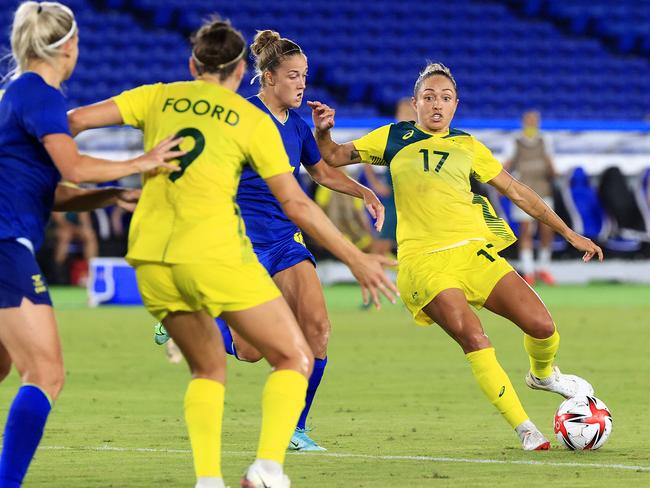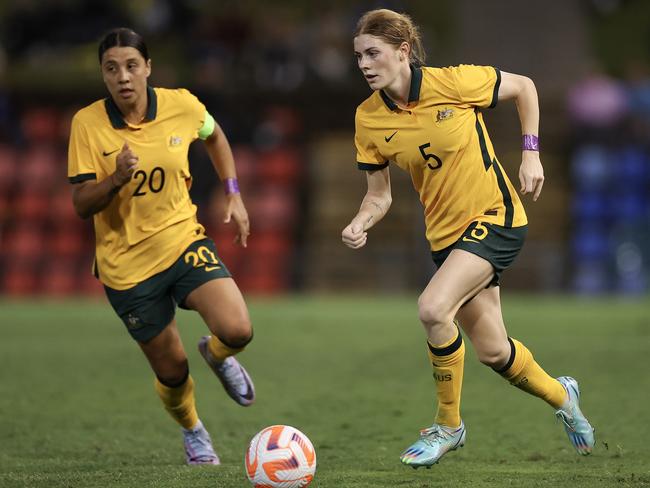Adam Peacock: The toughest calls in risky Matildas World Cup squad named by Tony Gustavsson
There are obvious risks in the Matildas World Cup squad named by Tony Gustavsson and a particularly brutal omission, writes ADAM PEACOCK.

Women's Football
Don't miss out on the headlines from Women's Football. Followed categories will be added to My News.
At some point for a manager trying to win big, risk will pay a visit – so why not welcome it in before the whole show starts?
Tony Gustavsson has done as much in naming his 23 players to take on the world later this month.
He had no choice. A number of his established stars are recovering from injuries of varying severity. Some from a year out, others with recent knocks, so there is risk of varying degrees.
On face value, Kyah Simon’s inclusion looks like a huge gamble. The creative forward is eight months removed from rupturing her ACL and yet to play in any match of any kind since last October.
Other veterans like Alanna Kennedy (hamstring, shoulder, calf) and Tameka Yallop (ankle) have played next to no football in 2023, but are trusted.
Unlike Chloe Logarzo. A walk-up starter if fit, the midfielder’s exclusion after a long rehab from knee and foot problems is the most contentious call.

*****
Simon, one of nine Matildas in the squad with more than 100 caps, hasn’t played a game since last October, when she ruptured her ACL playing for Tottenham.
The striker has been eased back, even through the past fortnight at the Matildas’ pre-camp on the Gold Coast, with minimal contact sessions.
That process will continue for the next fortnight in Melbourne and it remains to be seen if Simon plays any part in the lone warm-up game, against France on July 14 on Marvel Stadium’s notoriously rock-hard surface.
Should Simon make it onto the pitch against Ireland in the World Cup opener on July 20, it will have been 291 days since her injury. It isn’t a miracle, per se; Ellie Carpenter resumed after 259 days out with an ACL injury.
Gustavsson’s invitation of risk is based on the fact that Simon scores big goals in big moments.
In the 2011 World Cup, while still supplementing her football career financially by working at Rebel Sport, Simon popped up with two goals in the last group game against Norway to send Australia to the knockout stages.
Then in 2015, she was in the right spot at the right time against Brazil, pouncing on a spilt shot from Lisa De Vanna to give the Matildas their first and only knockout stage win.
Simon cruelly missed out in 2019, unable to convince then-coach Ante Milicic that she was ready after an ankle injury, only for her diligent, around-the-clock recovery to pay off this time.
Larissa Crummer is the unlucky one to make way, despite featuring in every squad in the past 12 months and even starting recent games against Jamaica and Scotland as back-up to Sam Kerr.

*****
Logarzo’s omission is the most brutal call.
Her return from an ACL injury suffered for the Matildas against Ireland in September 2021 hasn’t been smooth, with foot issues plaguing her A-League Women’s campaign with Western United.
At her best, Logarzo’s energy with and without the ball is an absolute asset, but whatever has been on display in the Gold Coast pre-camp hasn’t satisfied Gustavsson.
With good reason, Logarzo could look to others carrying physical ailments into the World Cup and ask why she was singled out.
Yallop, Kennedy, Clare Polkinghorne, Emily van Egmond and Mary Fowler haven’t had a clean bill of health of late.
Ultimately, what looks to have counted against Logarzo is the depth in central midfield, with Katrina Gorry, Clare Wheeler, van Egmond and the adaptable Yallop preferred; while Fowler can be utilised either on the front line or as an attacking midfielder, particularly if Gustavsson elects to play a 4-3-3 formation as opposed to the 4-4-2 he has slanted to of late.

*****
The overall mix of the squad in terms of youth and experience is balanced, which wasn’t going to be the case three years ago.
A non-negotiable part of Gustavsson’s remit from Football Australia was to build depth. He went to an extreme, with 54 players used (45 on the pitch) since his first games in charge, thumpings by Germany and The Netherlands in April 2021.
Since then, 19 players have debuted to tick off that particular KPI. It will make for a nice line on Gustavsson’s LinkedIn page one day.
Importantly though, of the 19 debutants, six have made the World Cup squad: Charli Grant, Clare Hunt, Courtney Nevin, Kyra Cooney-Cross, Clare Wheeler and Cortnee Vine.

Hunt, Cooney-Cross and Vine appear likely to start the first game against Ireland. Trust in the latter, Sydney speedster Vine, points heavily toward the attribute Gustavsson will look for against the bigger teams.
Speed.
Vine, Hayley Raso, Caitlin Foord and of course, Sam Kerr, all cause havoc with direct, instinctive running.
There is little back-up for that plan, though. Simon is lightning quick between the ears but not express pace, and with 54-cap veteran Emily Gielnik left out, depth is scant in wide attacking areas.
It is a big risk to go in light for such an important cog in the game plan, yet one Gustavsson is happy to take.

This will be the first Women’s World Cup with the five-sub rule (up from three), so the importance of squad depth has never been greater, even though the Matildas can’t rotate starting line-ups through the group stage when faced with a lighter opponent, such as the USA’s 13-0 opener against Thailand four years ago.
Ireland will be a nervy affair, Nigeria – led by Barcelona striker Asisat Oshoala – will pose a different threat and the final group clash with Olympic gold medallists Canada speaks for itself in terms of importance.
Then the knockout stages.
The seven-game path to a World Cup triumph, hoped for more than expected even after the squad announcement, will be perilous.
So why not get comfortable with risk at the start line?
Originally published as Adam Peacock: The toughest calls in risky Matildas World Cup squad named by Tony Gustavsson



